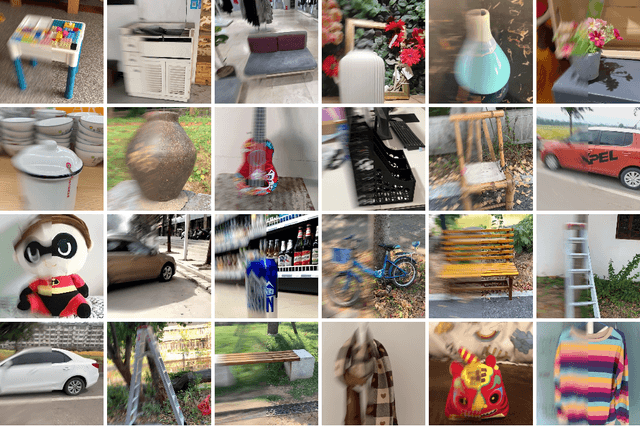Joonkyu Park
GS-Blur: A 3D Scene-Based Dataset for Realistic Image Deblurring
Oct 31, 2024



Abstract:To train a deblurring network, an appropriate dataset with paired blurry and sharp images is essential. Existing datasets collect blurry images either synthetically by aggregating consecutive sharp frames or using sophisticated camera systems to capture real blur. However, these methods offer limited diversity in blur types (blur trajectories) or require extensive human effort to reconstruct large-scale datasets, failing to fully reflect real-world blur scenarios. To address this, we propose GS-Blur, a dataset of synthesized realistic blurry images created using a novel approach. To this end, we first reconstruct 3D scenes from multi-view images using 3D Gaussian Splatting (3DGS), then render blurry images by moving the camera view along the randomly generated motion trajectories. By adopting various camera trajectories in reconstructing our GS-Blur, our dataset contains realistic and diverse types of blur, offering a large-scale dataset that generalizes well to real-world blur. Using GS-Blur with various deblurring methods, we demonstrate its ability to generalize effectively compared to previous synthetic or real blur datasets, showing significant improvements in deblurring performance.
Recurrence-in-Recurrence Networks for Video Deblurring
Mar 12, 2022



Abstract:State-of-the-art video deblurring methods often adopt recurrent neural networks to model the temporal dependency between the frames. While the hidden states play key role in delivering information to the next frame, abrupt motion blur tend to weaken the relevance in the neighbor frames. In this paper, we propose recurrence-in-recurrence network architecture to cope with the limitations of short-ranged memory. We employ additional recurrent units inside the RNN cell. First, we employ inner-recurrence module (IRM) to manage the long-ranged dependency in a sequence. IRM learns to keep track of the cell memory and provides complementary information to find the deblurred frames. Second, we adopt an attention-based temporal blending strategy to extract the necessary part of the information in the local neighborhood. The adpative temporal blending (ATB) can either attenuate or amplify the features by the spatial attention. Our extensive experimental results and analysis validate the effectiveness of IRM and ATB on various RNN architectures.
* accepted paper in BMVC 2021
 Add to Chrome
Add to Chrome Add to Firefox
Add to Firefox Add to Edge
Add to Edge